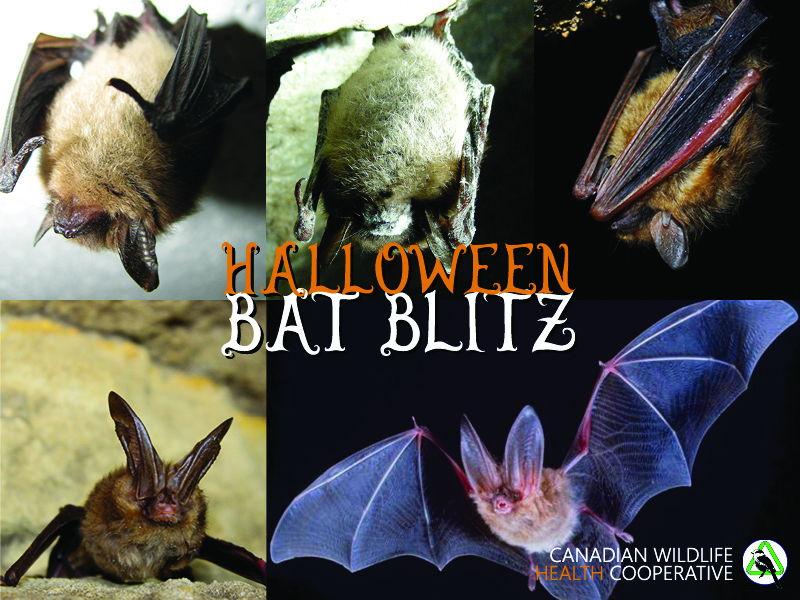Bat Blitz 2014 Revisited
 North American bat populations have been under extreme pressure in recent years. White-nose syndrome has devastated populations of several species of bats, resulting in three previously-abundant species in Canada being listed as endangered by the end of 2014. Many organizations and researchers are working tirelessly to better understand and stop the spread of this fungal disease, as well as to alleviate other pressures facing North American bats. A huge part of this work has involved trying to change public perception of bats: dispelling myths about bats, eliminating their reputation as “vermin”, and educating people on the critically important role of bats in the ecosystem.
North American bat populations have been under extreme pressure in recent years. White-nose syndrome has devastated populations of several species of bats, resulting in three previously-abundant species in Canada being listed as endangered by the end of 2014. Many organizations and researchers are working tirelessly to better understand and stop the spread of this fungal disease, as well as to alleviate other pressures facing North American bats. A huge part of this work has involved trying to change public perception of bats: dispelling myths about bats, eliminating their reputation as “vermin”, and educating people on the critically important role of bats in the ecosystem.
In the weeks surrounding Halloween 2014, we launched a social media campaign to raise awareness and understanding about bats. This “Bat Blitz” included a variety of posts focusing on white-nose syndrome and other threats, bat research, and changing public perception of bats. Next week, we will be joining many other organizations in celebrating Bat Week (October 25-31, 2015) with our own Bat Blitz 2015! Please join us as we celebrate bats and the people working to safeguard the future of these incredibly important animals. This week, we encourage you to take a moment to revisit some of the great material from CWHC’s Bat Blitz 2014!
Craig Stephen’s introduction to Bat Blitz 2014:
Bat contributions to human lives:
According to Agriculture and Agri-Food Canada, insect pests can cause up to 35% loss in field crop harvests. A single Canadian little brown bat (that’s just one species of many in Canada!) can eat up to a kilogram of insects each and every summer, which could offset insect related crop damage and reduce the need for harmful pesticides which can end up in our food…read more
Challenges facing bat populations:
Unfortunately, one of the biggest threats to bats remains human beings. Habitat destruction and modification causes all manner of problems for bats, particularly those related to agricultural intensification. Deforestation robs certain types of bats of their day time roosts. Caving activity can disturb hibernating bats because it wakes them up, causing them to burn off energy reserves they need to preserve to last through the harsh Canadian winters…read more
Stéphane Lair’s introduction to white-nose syndrome:
Instructions for removing bats from the home:
If a bat does end up in your house, or garage etc. the chances are that it’s lost. Don’t panic and please don’t kill the bat. Bats, like spiders, can be safely removed from the home and released back into wild at no significant risk to you or your family…read more
Bat conservation organizations:
Understanding and protecting bats is a joint effort. There are currently dozens of federal, provincial, and state agencies both in the US and Canada, as well as a great many NGOs, conservation groups, and individuals all working toward safeguarding the future success of bat populations across North America…read more
Marnie Zimmer’s tour of the WCVM necropsy lab:
Spread of white-nose syndrome in North America:
Since 2007 White-nose Syndrome (WNS) has been associated with deaths of more than 5.5 million cave bats, first in the north-eastern United States, but since the disease was first identified, it has consistently spread in all directions, north, south, east and west. WNS was first confirmed in south-western Quebec and central and north-eastern Ontario in the 2009/10 surveillance season. In the 2010/11 season, it was detected in New Brunswick and Nova Scotia. It was not detected in any new provinces during the 2011/12 surveillance season although it continued to spread to new areas within provinces and move much farther south and west in the United States. In the 2012/13 WNS surveillance season the disease was detected for the first time in Prince Edward Island…read more
How to build a bat box:
Building a bat box is an easy way to help bats find safe and warm places to hole up during the day. Remember, bats eat lots and lots of insects, so if you have a garden, these little insectivores could be a great benefit to you…read more
Scott McBurney on protecting bat habitat in PEI:
White-nose challenge on Facebook:
We challenged our supporters to show their support in a fun way, by posting photos of themselves with white noses! Check out some of the great responses here.
Reducing human-caused spread of WNS:
One of the ways that White Nose Syndrome (the disease wiping out bats in the US and Canada) is believed to have been introduced to North America is by improper or inadequate cleaning of caving equipment by cavers who carried P.d. spores into caves in the North Eastern United States. Decontamination protocols have now been established that can help reduce the risk of the fungus spreading in this fashion…read more
CWHC welcomes Jordi Segers, new white-nose syndrome coordinator:
We hope you enjoyed last year’s Bat Blitz! Stay tuned next week for Bat Blitz 2015!
Submitted by Erin Moffatt, CWHC National Office


